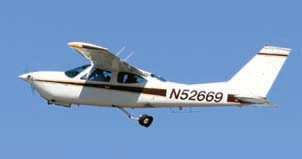
121
I am glad to see attention given to single-engine overwater flights (“One If By Land, Two If By Sea?” June 2012). As a frequent traveler to the Bahamas in my 1981 Beech Sierra, this is of particular interest to me.
One of my concerns has been the disorienting period of trying to escape a sinking plane while having to fight panic and hold a single breath while finding an exit. As a result, I added one piece of safety equipment not mentioned in your article that I feel deserves consideration. I now equip every seat with a “Spare Air” bottle. This is a simple five-minute, self-contained scuba-type breathing device.
Often sold as backups for divers or escape air for helicopter crews, they only require one to pull a cap (even this is optional), place the mouthpiece in your mouth and breathe. Simple enough to learn by instruction or with a single practice breath. They only weigh about two pounds each, are small enough to wear on a belt, and at less than $300 on the street seem to be a valid option to improve one’s survival chances in case of a water ditching.
I have no business relationship with anyone or company that makes or sells these things. I just think they are simple additions to add to choice of equipment for overwater flying
Paul Werbin, ATP/CFI
Via e-mail
As that article explored, egressing a ditched aircraft isn’t nearly as easy as it might seem. You might be upside down, injured and/or disoriented. Underwater visibility can be limited and the water is cold. A human’s natural buoyancy and finding and using the nearest exit can easily consume more time than that last big breath can support.
Learn more about Spare Air products at the company’s Web site, www.spareair.com. We have no experience with this product and, like Mr. Werbin, no affiliation with the company.

302
Go Arounds
Eons ago I worked as a primary flight instructor. I was out with one of my first students, inherited from another instructor, and I pulled the power on him to see how he would do with the 25-knot prevailing wind.
As I expected, it soon became obvious he would end up in the canyon just short of the cropduster strip he was aiming for. I held off until even he realized we weren’t going to make it, then told him to go around. His hand, which had up to that point firmly clenched the throttle, immediately went to the flap handle and he fully retracted the flaps! I took over, we sank like a stone, flew the length of the runway in ground effect and managed to get enough speed and altitude to get over the power lines at the end.
The relevance to your article is this: nothing will arrest the descent of a plane except the addition of power. So why on earth is adding power the fourth item on your list? Prop and mixture? Why are they not already set for the go-around, if you are planning every landing as if it will not happen? Doesn’t every pre-landing check list for piston aircraft specify prop and mixture full forward (or as dictated by altitude)? Carb heat? Never mind carb heat—it has a minor effect on power production and can be dealt with later.
Bottom line: Configure the plane properly in the first place and keep your hand on the throttle. If the go-around is needed, add power, establish pitch, etc. Once the plane is verified to be climbing and pointing straight, then sort out the carb heat, trim and cowl flaps.
And the last thing is to talk on the radio. This all works when initiating a missed approach as well.
Wim Kimmerer
Berkeley, Calif.
One of our concerns in developing that article is what can happen when low and slow in the landing configuration and the pilot immediately adds maximum power. As we noted, a torque-induced rollover or other low-speed/high-power problems aren’t likely to occur with a Cessna 150, but can happen with more powerful airplanes. Bad things also can happen with a twin if we get below VMC on final, then add full power, only to find one engine isn’t staying with the program.
Rather than immediately add full power, we prefer to add some power immediately to arrest the descent, allowing us to ensure the airplane is reacting as it should, then bring up the rest of it while re-trimming and re-configuring the airplane for the climb.
Putting all the engine controls except the throttle fully forward before landing is on most checklists. However, when arriving at reduced power and from a relatively high cruising altitude, some pilots opt to leave the mixture control set for lean operation and don’t run the prop control to high rpm for noise-abatement reasons. That’s why we wrote that checklist as we did.
LOP Mag Checks
The June 2012 article on magnetos (“The Sparks That Let You Fly”) was very complete. The sidebar “Extreme Mag Checks” had one statement that might need improvement: “Performing an in-flight mag check while running lean of peak EGT puts the most ‘stress’ on the ignition system, thanks in part to the leaner fuel/air mixture, which is more difficult to ignite.”
The magneto ignition system itself cannot determine the quality of mixture in the combustion chamber. What it does “feel” is the voltage on the coil lead to the spark plug at the moment of spark discharge. A higher combustion chamber pressure results in more electrical resistance (with more insulating non-conductive air and fuel atoms in the way) and a resulting higher air ionization potential voltage that must be exceeded by the collapsing magnetic field energy in the coil to allow the first current to flow in the eventually ionized and conductive high pressure air (and hopefully, fuel) charge at the moment of spark.
So higher combustion chamber pressure puts more electrical voltage stress on the insulation materials in the coil, harness wires and spark plugs. The rest of the mechanical components really don’t see this stress increase, and the important dynamic stress is purely electrical after the mechanical components are done storing energy in the magnetic field of the coil.
The above isn’t true of all ignition systems. Modern automobile electronic ignition systems use sensors and microprocessors to determine primary ignition timing, optimize power and ensure combustion completeness. That level of sophistication simply does not apply to anything about aircraft magnetos and the stress they feel from lean or rich of peak ignition system operation.
Ignition system stress in an airplane is mostly just a function of combustion chamber pressure. A healthy magneto system has enough operational margin to overcome any conceivable combustion chamber pressure resistance to ionization (even beyond mechanically destructive detonation ignition) without feeling meaningfully stressed regardless of whether the left-right magneto test is done at medium or full power, whether on the ground or in flight. After all, when grounded, that magneto has minimal electrical stress until it is ungrounded back to its normal operational status.
Robert Patlovany
Westminster, Colo.




